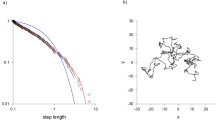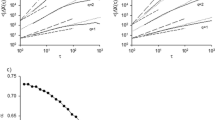Abstract
Weierstrassian Lévy walks are one of the simplest random walks which do not satisfy the central limit theorem and have come to epitomize scale invariance even though they were initially regarded as being a mathematical abstraction. Here, I show how these Lévy walks can be generated intrinsically as a by-product of crawling, a common but ancient form of locomotion. This may explain why Weierstrassian Lévy walks provide accurate representations of the movement patterns of a diverse group of molluscs—certain mussels, mud snails and limpets. I show that such movements are not specific to molluscs as they are also evident in Drosophila larvae. The findings add to the growing realization that there are many idiosyncratic, seemingly accidental pathways to Lévy walking. And that the occurrence of Lévy walks need not be attributed to the execution of an advantageous searching strategy.
Graphic abstract





Similar content being viewed by others
Data Availability Statement
This manuscript has associated data in a data repository. [Authors’ comment: The data that support the findings of this study were obtained by Sims et al. [15].The data are freely available at https://elifesciences.org/articles/50316.]
References
A.M. Reynolds, Liberating Lévy walk research from the shackles of optimal foraging. Phys. Life Rev. 14, 59–83 (2015)
A.M. Reynolds, Current status and future directions of Lévy walk research. Biol. Open 7, bio030106 (2017)
A.M. Reynolds, Mussels realize Weierstrassian Lévy walks as composite correlated random walks. Sci. Rep. 4, 4409 (2014)
A.M. Reynolds, F. Bartumeus, A. Kölzsch, J. van de Koppel, Signatures of chaos in animal search patterns. Sci. Rep. 6, 23492 (2016)
A.M. Reynolds, G. Santini, G. Chelazzi, S. Focardi, The Weierstrassian movement patterns of snails. Roy. Soc. Open Sci. 4, 160941 (2017)
G. Ariel, A. Be’er, A.M. Reynolds, Chaotic model of Lévy walks in swarming bacteria. Phys. Rev. Lett. 118, 228102 (2017)
J. Klafter, M.F. Schlesinger, G. Zumofen, Beyond Brownian motion. Phys. Today 49, 33–39 (1996)
B.D. Hughes, M.F. Schlesinger, E.W. Montroll, Random walks with self-similar clusters. Proc. Natl. Acad. Sci. USA 78, 3287–3291 (1981)
G.M. Zaslavsky, D. Stevens, H. Weitzner, Self-similar transport in incomplete chaos. Phys. Rev. E 48, 1683–1694 (1993)
G.M. Zaslavsky, From Hamiltonian chaos to Maxwell’s Demon. Chaos 5, 653–661 (1995)
J. Loveless, K. Lagogiannis, B. Webb, Modelling the mechanics of exploration in larval Drosophila. PLOS Comp. Biol. 5, e1006635 (2019)
G.M. Viswanathan, E.P. Raposo, M.G.E. da Luz, Lévy flights and super diffusion in the context of biological encounters and random searches. Phys. Life Rev. 5, 133–150 (2008)
N. Levernier, J. Textor, O. Bénichou, R. Voituriez, Inverse square Lévy walks are not optimal search strategies for \(d\geqslant 2\). Phys. Rev. Lett. 124, 080601 (2020). See Reynolds A.M. Extending Lévy search theory from one to higher dimensions: Lévy walking favours the blind. Proc. Roy. Soc. A 471, 20150123 (2015)
J.H. Lai, J.C. del Alamo, J. Rodriguez-Rodriguez, J.C. Lasheras, The mechanics of the adhesive locomotion of terrestrial gastropods. J. Exp. Biol. 213, 3920–3933 (2010)
D.W. Sims, N.E. Humphries, N. Hu, V. Meda, J. Berni, Optimal searching behaviour generated intrinsically by the central pattern generator for locomotion. eLife 8, e50316 (2019)
N.E. Humphries, H. Weimerskirch, D.W. Sims, A new approach for objective identification of turns and steps in organism movement data relevant to random walk modelling. Meth. Ecol. Evol. 4, 930–938 (2013)
A. Clauset, C.R. Shalizi, M.E.J. Newman, Power-law distributions in empirical data. SIAM Rev. 51, 661–703 (2009)
M.S. Abe, Functional advantages of Lévy walks emerging near a critical point. Proc. Nat. Acad. Sci. 117, 24336–24344 (2020)
H. Hayashi, S. Ishizuka, M. Ohta, K. Hirakawa, Chaotic behavior in the onchidium giant neuron under sinusoidal stimulation. Phys. Lett. A. 88, 435–438 (1982)
A.O. Komendantov, N.I. Kononenko, Deterministic chaos in mathematical model of pacemaker activity in bursting neurons of snail. Helix Pomatia. J. Theor. Biol. 183, 219–230 (1996)
A.M. Reynolds, Passive particles Lévy walk through turbulence mirroring the diving patterns of marine predators. J. Phys. Comm. 2, 085003 (2018)
A.M. Reynolds, J.G. Cecere, V.H. Paiva, J.A. Ramos, S. Focardi, Pelagic seabird flight patterns are consistent with a reliance on olfactory maps for oceanic navigation. Roy. Soc. Proc. B 282, 20150468 (2015)
M.L. Rabinovich, H.D.I. Abarbanel, The role of chaos in neural systems. Neurosci. 87, 5–14 (1998)
S. Kuroda, I. Kunita, Y. Tanaka, A. Ishiguro, R. Kobayashi, T. Nakagaki, Common mechanics of mode switching in locomotion of limbless and legged animals. J. Roy. Soc. Int. 11, 20140205 (2014)
M.F. Shlesinger, Weierstrassian Lévy flights and self-avoiding random walks. J. Chem. Phys. 78, 416–420 (1982)
D.W. Sims, A.M. Reynolds, V.J. Wearmouth, N.E. Humphries, E.J. Southall, B. Metcalfe et al., Hierarchical random walks in trace fossils and the origin of optimal search behaviour. Proc. Nat. Acad. of Sci. USA 111, 11073–11078 (2014)
Acknowledgements
The work at Rothamsted forms part of the Smart Crop Protection (SCP) strategic programme (BBS/OS/CP/000001) funded through Biotechnology and Biological Sciences Research Council’s Industrial Strategy Challenge Fund.
Author information
Authors and Affiliations
Contributions
A.M.R. undertook the research and wrote the paper.
Corresponding author
Rights and permissions
About this article
Cite this article
Reynolds, A.M. Weierstrassian Lévy walks are a by-product of crawling. Eur. Phys. J. E 44, 96 (2021). https://doi.org/10.1140/epje/s10189-021-00100-2
Received:
Accepted:
Published:
DOI: https://doi.org/10.1140/epje/s10189-021-00100-2




